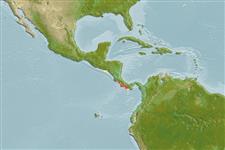Classification / Names
Common names | Synonyms | Catalog of Fishes(genus, species) | ITIS | CoL | WoRMS | Cloffa
Teleostei (teleosts) >
Ovalentaria/misc (Various families in series Ovalentaria) >
Opistognathidae (Jawfishes)
Etymology: Opistognathus: Greek, opisthe = behind + Greek, gnathos = jaw (Ref. 45335); to the very elongate upper jaw of the type species of the genus, Opistognathus nigromarginatus (Ref. 128653); smithvanizi: Named for William F. Smith-Vaniz.
Eponymy: Dr William Farr ‘Bill’ Smith-Vaniz (d: 1941) is a Research Associate of the Florida Museum of Natural History, researching into the diversity and evolutionary relationships of fishes. [...] (Ref. 128868), visit book page.
Environment: milieu / climate zone / depth range / distribution range
Ecology
Marine; demersal; depth range 9 - 20 m (Ref. 75633). Tropical
Eastern Central Pacific: Costa Rica.
Size / Weight / Age
Maturity: Lm ? range ? - ? cm
Max length : 5.6 cm SL male/unsexed; (Ref. 75633)
Short description
Identification keys | Morphology | Morphometrics
Dorsal spines (total): 10 - 11; Dorsal soft rays (total): 16 - 17; Anal spines: 3; Anal soft rays: 16; Vertebrae: 29. This small (4.8-5.6 cm), robust species possess the following combination of characters: upper jaw sexually dimorphic, males' maxilla longer and with two dark stripes on inner lining; 16-17 dorsal-fin soft rays; A III; 81- 94 oblique scale rows in longitudinal series; 22-25 gill rakers on lower limb of first arch; body with 5 wide dusky bars overlain with diffuse spotting; faint, non-ocellated oval blotch in spinous dorsal, between spines 4 and 7; anterior nostril with an unbranched club-shaped cirrus; buccal pigmentation; large orbit, 2.8-3.1 in HL; short head, its length 2.8-3.0 in SL; long upper jaw length, in males 1.3-1.4 and in females 1.7 in HL; 19 caudal vertebrae (Ref. 75633).
Found over rocky/sandy substrates (Ref. 75633).
Life cycle and mating behavior
Maturity | Reproduction | Spawning | Eggs | Fecundity | Larvae
Bussing, W.A. and R.J. Lavenberg, 2003. Four new species of eastern tropical Pacific jawfishes (Opistognathus: Opistognathidae). Rev. Biol. Trop. 51(2):529-550. (Ref. 75633)
IUCN Red List Status (Ref. 130435: Version 2024-1)
Threat to humans
Harmless
Human uses
Tools
Special reports
Download XML
Internet sources
Estimates based on models
Phylogenetic diversity index (Ref.
82804): PD
50 = 0.5000 [Uniqueness, from 0.5 = low to 2.0 = high].
Bayesian length-weight: a=0.00389 (0.00180 - 0.00842), b=3.12 (2.94 - 3.30), in cm total length, based on all LWR estimates for this body shape (Ref.
93245).
Trophic level (Ref.
69278): 3.3 ±0.5 se; based on size and trophs of closest relatives
Fishing Vulnerability (Ref.
59153): Low vulnerability (10 of 100).
